Antibody data
- Antibody Data
- Antigen structure
- References [1]
- Comments [0]
- Validations
- Immunocytochemistry [4]
- Immunohistochemistry [1]
- Other assay [1]
Submit
Validation data
Reference
Comment
Report error
- Product number
- PA5-20570 - Provider product page

- Provider
- Invitrogen Antibodies
- Product name
- Lass5 Polyclonal Antibody
- Antibody type
- Polyclonal
- Antigen
- Synthetic peptide
- Description
- A suggested positive control is rat brain tissue lysate. PA5-20570 can be used with blocking peptide PEP-0690.
- Reactivity
- Human, Mouse, Rat
- Host
- Rabbit
- Isotype
- IgG
- Vial size
- 100 μg
- Concentration
- 1 mg/mL
- Storage
- Maintain refrigerated at 2-8°C for up to 3 months. For long term storage store at -20°C
Submitted references The glucocorticoid-Angptl4-ceramide axis induces insulin resistance through PP2A and PKCζ.
Chen TC, Benjamin DI, Kuo T, Lee RA, Li ML, Mar DJ, Costello DE, Nomura DK, Wang JC
Science signaling 2017 Jul 25;10(489)
Science signaling 2017 Jul 25;10(489)
No comments: Submit comment
Supportive validation
- Submitted by
- Invitrogen Antibodies (provider)
- Main image
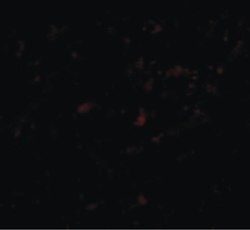
- Experimental details
- Immunofluorescent analysis of human brain cells using a LASS5 polyclonal antibody (Product # PA5-20570) at a 20 µg/mL dilution.
- Submitted by
- Invitrogen Antibodies (provider)
- Main image
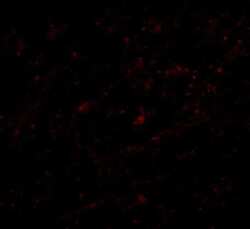
- Experimental details
- Immunofluorescence of LASS5 in Human Brain cells with Lass5 Polyclonal Antibody (Product # PA5-20570) at 20 µg/mL.
- Submitted by
- Invitrogen Antibodies (provider)
- Main image
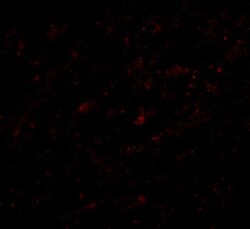
- Experimental details
- Immunofluorescence of LASS5 in Human Brain cells with Lass5 Polyclonal Antibody (Product # PA5-20570) at 20 µg/mL.
- Submitted by
- Invitrogen Antibodies (provider)
- Main image
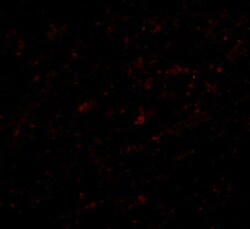
- Experimental details
- Immunofluorescence of LASS5 in Human Brain cells with Lass5 Polyclonal Antibody (Product # PA5-20570) at 20 µg/mL.
Supportive validation
- Submitted by
- Invitrogen Antibodies (provider)
- Main image
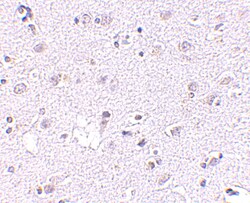
- Experimental details
- Immunohistochemistry of LASS5 in human brain tissue with Lass5 Polyclonal Antibody (Product # PA5-20570) at 2.5 µg/mL.
Supportive validation
- Submitted by
- Invitrogen Antibodies (provider)
- Main image
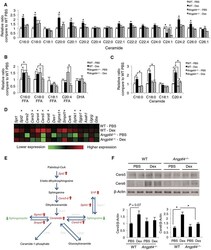
- Experimental details
- Fig. 4. Dexamethasone-activated hepatic ceramide synthetic program was attenuated in Angptl4 -/- mice. WT and Angptl4 -/- mice were treated with PBS or dexamethasone for 7 days. ( A to C ) The concentrations of 16 different ceramide species in the liver (A), 5 different free fatty acids (FFAs) in plasma (B), and 4 ceramide species in plasma (C) of these mice were measured. n = 4 mice per group. ( D ) The expression of genes encoding enzymes involved in ceramide production was monitored using quantitative polymerase chain reaction (qPCR). The heat map shows the relative expression compared to that in the WT PBS group. Red shading on the heat map indicates higher expression, and green shading represents lower expression. The changes in fold induction are shown in fig. S1 . n = 16 mice per group. ( E ) Schematic representation of ceramide synthesis pathways. The genes and metabolites that were induced by dexamethasone in WT mice liver are shown in red. The metabolites that were reduced by dexamethasone are shown in green. ( F ) The abundance of Cers5 and Cers6 proteins was monitored using Western blot. The bar graph represents the average intensity of bands normalized to those for Gapdh. Error bars represent SEM. n = 3 to 4 mice per group. * P < 0.05.
 Explore
Explore Validate
Validate Learn
Learn Western blot
Western blot Immunocytochemistry
Immunocytochemistry